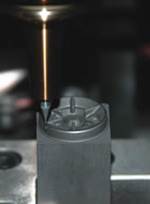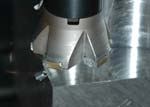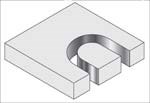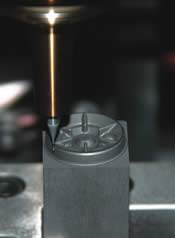Plunge Milling Saves Time on Big Mold Cavities
By using a plunge mill, what used to take four hours now takes only 30 minutes—and stretches mold feedstock.
Next time you have a huge mold cavity to create, consider nibbling around the edges rather than hogging it out entirely. You will save some time, and may even salvage some material for another job.
Ask Randy Fields at Fremont Plastic Molds (Fremont, OH). He saved three hours apiece roughing big U-shapes into eight thick aluminum mold sections, and salvaged enough useable material from each section to make other mold parts as well. What used to take four hours now takes only 30 minutes—and stretches mold feedstock.
The job is to cut a 42-inch long by 13-inch wide U-shape, clear through, into a 62 x 24 x 8-inch aluminum billet, and do it on a vertical mill. In the past, Fields did this type of job by ramp-milling the cavity with a button cutter at about 0.100 inches depth-of-cut. Four hours later with that process, he had a roughed-out mold section and a huge pile of chips. In another two hours of finish-milling, he had a completed piece—and still more chips.
Ingersoll application engineer Bob McAlindon, who noticed how long the job was taking, suggested stepping a plunge mill around the outline of the U-shape instead. "Plunge milling would complete the part faster, and chip evacuation wouldn't be a problem since it's a through-cut," McAlindon reasoned. "The chips would fall out of the bottom. And when we cut just around the outline, we salvage a good chunk of useable metal in the middle. We excise the center portion rather than pulverizing it."
Plunge Right In
Fields was dubious about the prospect of taking such heavy, deep cuts on a limited-horsepower Mighty vertical CNC machine. So McAlindon ran a demo himself, using a 2 ½-inch V-Max™ Ingersoll plunging cutter mounted to an Ingersoll 11-inch D'Andrea extension, to provide the necessary reach. Despite the light machine and the long extension, he programmed the cut at 2000 sfpm, 80 ipm and 0.450- in stepovers between cuts, starting at the outside edge.
Even with the long tool overhang on the light-duty machine, the demo went fine. No chatter, no vibration. And when the cut was done, Fremont wound up with an 8" x 38" piece of perfectly useable leftovers.
Plunge milling the outline this way created a scalloped edge, which was then finished in two hours—the same as before—with the same tool and stepover decreased to 0.025 in. The total time was 2:30 vs. 5:30.
Based on that demo, Fields became a believer and Fremont adopted the method. They ordered two of the plunge cutters and called their programming house MasterCam to update the process commands accordingly.
Feeding Faster
Fremont operators ran the remaining seven parts themselves, building on McAlindon's settings. By the time the second part was done, Fremont was feeding at 200 ipm. Based on a $40/hr shop rate, Fields estimates a $1,120 savings on this job alone, and the potential to use the same Z-plunge method regularly on other jobs. "We recouped the cost of the two cutters after only two parts," Fields added.
As it turns out, Fremont has a call for the Z-plunge method about once a month on average, and expects to save about $12,000 a year given their current workload. "Z-plunge milling isn't for every big-cavity job here, because all of our mills are verticals," explains Fields. "On a vertical machine, Z-plunge milling works only on through-cuts because of the chip clearance issue. If we had horizontal machines, the chips would fall out on their own. We could Z-plunge blind cavities too."
Main Force on Strongest Axis
The key to success with plunge milling is that the main cutting forces on the tool and spindle are axial, along the vector of the tool's greatest strength. No side forces to bend and snap the tool, just compression. So you can turn up the feed without risk of damaging the tool. Ramping, by contrast, puts a lot of lateral forces on the cutter—necessitating slower feeds and lighter cuts.
The Ingersoll plunge cutter itself boasts a double positive presentation geometry that reduces cutting forces as the cutter rips through the metal. The cutter has five inserts, spaced so that they are never directly opposite each other, and thus not subject to pinching if used in a boring mode. Each insert has four cutting edges.
Other shops report similar throughput improvements in steel molds. The limit for material removal stems more from horsepower limitations of the machine than load limits on the rugged cutter.
Summary
On large-section through cuts, plunge milling can save time and money and also create salvageable material, even on low-HP machines. But be sure there's a clear path for chip takeaway when using vertical machines. The chips will build up fast.
Related Content
Tips for Tackling Mold Design, Machining, Cutting Tool and Wear Challenges
Tips for tasks ranging from reducing risk in part design and taking advantage of five-axis machining to refining cutting tool performance and reducing wear with guiding and centering systems.
Read MoreThree Good Reasons to Switch from Three- to Five-Axis Machining in Moldmaking
Five-axis machining technology is a great tool in the moldmaker toolbox.
Read MoreSolving Mold Alignment Problems with the Right Alignment Lock
Correct alignment lock selection can reduce maintenance costs and molding downtime, as well as increase part quality over the mold’s entire life.
Read MoreRead Next
High-Speed Mill Keeps Tight Tolerances, Increases Efficiencies
Busy moldmaker turns to HSM to boost productivity and remain competitive in both the domestic and foreign arenas—and realizes time savings of up to 60 percent.
Read MoreReasons to Use Fiber Lasers for Mold Cleaning
Fiber lasers offer a simplicity, speed, control and portability, minimizing mold cleaning risks.
Read MoreHow to Use Strategic Planning Tools, Data to Manage the Human Side of Business
Q&A with Marion Wells, MMT EAB member and founder of Human Asset Management.
Read More













.png;maxWidth=300;quality=90)









